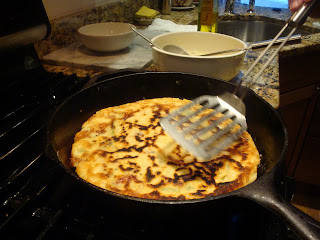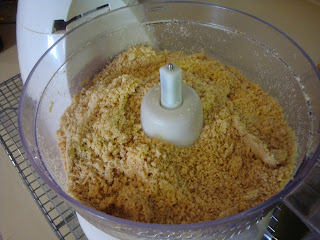
Yes, it did take forever to lay the apples out like that.
When it gets to be springtime, I start getting really antsy about fruits and vegetables. I want them to come now! Now! NOW! and become very disappointed when I go to the farmer's market and my only choice is what type of apple to use.
But I decided to make the best of it and have an apple tart for Easter dinner dessert.
It was a good choice. This tart is only lightly sweet. You sprinkle on about a tablespoon of sugar AFTER you've laid the apples out. As a result, the apples themselves start pretty crisp and provide most of the flavor.
My one beef is with the crust. Yes, it was nice and flaky. But boy was it a pain to roll out and get into the dish. The recipe was actually supposed to make enough crust to make this galette style, ie enough crust to fold over on top of the tart. Partly because I loaned out my good rolling pin and partly because I was being impatient and didn't refrigerate the crust long enough, that didn't happen. If I were to make this again, I might fall back on my mainstay crust recipe. Or, as my friend PJ recommended, I might break down and (gasp!) use shortening.
Simplest Apple Tart, adapted from Smitten KitchenEat Rating: Good. Not amazing. But definitely a solid dessert. The low sugar content was good for my relatives who need to monitor their sugar intake too.
Difficulty: Medium to hard, depending on how diligent you are with laying out the apples.
Crust1 cup all-purpose flour
1/2 tsp sugar
6 tbsp butter, cut into chunks
3-4 tbsp cold water
Filling
2 lbs apples (about 5-6)
2 tbsp butter, melted
1 tbsp sugar
Place the flour and sugar for the crust in the bowl of a food processor. Pulse to mix. Add the chunks of butter and pulse until a course meal forms. Adding water 1 tbsp at a time, continue to pulse just until the dough holds together. (LN: Alternatively, if you don't have a food processor, mix the flour and sugar in a bowl and use a pastry cutter to work the butter into the flour. Then use a hand mixer to incorporate the water)
Lay out a sheet of waxed paper. Remove the dough from the bowl and mound in the middle of the paper, smashing down to form a rounded disk. Wrap in the waxed paper and place in the fridge for at least a half hour.
While the dough is chilling, peel the apples. Cut in half along the stem. Using a melon baller, remove the core and stem. Laying the apple core-side down, cut the apple into thin pieces from top to bottom. Set cut apples aside.
By now, it should have been about 30 minutes. Preheat the oven to 400 degrees.
Remove the dough from the fridge and roll out. You will be using a 9-inch round tart pan, so you'll want to roll it out large than that by at least 1-1/2 inches (don't forget it has to go up the sides). (LN: You really do want to use a round tart pan. I was stuck because I have a 9-inch square and a 10-inch round. I went with the 9-inch square, and, as you can see above, there wasn't enough dough for the top overhang.)
Once it's rolled out, lay into the bottom of the tart pan, allowing the excess to hang over the sides. Lay out the apples. The easiest way to do this is to take each apple-half and fan it out so each piece overlaps the next a little (LN: This is also much easier to do when you're working with a round pan than when you're working with a square).
After you've laid out all the apples, take your melted butter and lightly brush the apples with it, reserving a little bit for the crust. Sprinkle about 1 tbsp of sugar over the apples. Gently fold the excess dough back over the top of the tart. Brush the crust with remaining butter and sprinkle lightly with sugar.
Bake for about 45 minutes, making sure to rotate the tart every 10-15 minutes so that it browns evenly.
Remove from oven and cool completely before trying to remove the outer tart pan (LN: I've made that mistake before. Not pretty). To remove the outer pan, place a sturdy can -- like a can of diced tomatoes or pumpkin -- on the counter. Set the tart on top. The tart should sit on top of the can, and the outer layer will fall to the counter.
Serve the tart warm or at room temperature, preferably with vanilla ice cream.








































